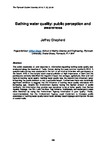Bathing water quality: public perception and awareness
| dc.contributor.author | Shepherd, J. | |
| dc.date.accessioned | 2019-05-16T15:22:46Z | |
| dc.date.available | 2019-05-16T15:22:46Z | |
| dc.date.issued | 2014 | |
| dc.identifier.citation |
Shepherd, J. (2014) 'Bathing water quality: public perception and awareness', The Plymouth Student Scientist, 7(2), p. 38-58. | en_US |
| dc.identifier.issn | 1754-2383 | |
| dc.identifier.uri | http://hdl.handle.net/10026.1/14068 | |
| dc.description.abstract |
The public awareness of, and response to, information regarding bathing water quality was evaluated along the beaches of Poole, Dorset, during the peak summer months in 2013. A questionnaire survey was conducted in the form of an informal interview with participants at the beach. 61% of the sample rated coastal pollution of high importance to them and the participants correctly identified the negative impact that sewage, agriculture, litter and fuel have on bathing water quality. Bathing water quality was the second most important factor influencing the public decision to visit a particular beach. Furthermore there was statistically significant evidence to suggest that the influence of bathing water quality decreases with increasing age. Despite the Environment Agency having the highest amount of public familiarity, the information they provide was perceived to be of lower quality than Surfers Against Sewage, the RNLI and the Blue Flag Scheme. Additionally non-watersports users were identified as rating the Environment Agency information of poor quality. Finally, recommendations that the Environment Agency could implement to increase public awareness of bathing water quality were made; develop beach signage and improve the use of social media. | en_US |
| dc.language.iso | en | en_US |
| dc.publisher | University of Plymouth | |
| dc.rights | Attribution 3.0 United States | * |
| dc.rights.uri | http://creativecommons.org/licenses/by/3.0/us/ | * |
| dc.subject | Bathing water quality | en_US |
| dc.subject | public attitudes | en_US |
| dc.subject | awareness | en_US |
| dc.subject | coastal pollution | en_US |
| dc.subject | Blue Flag Scheme | en_US |
| dc.title | Bathing water quality: public perception and awareness | en_US |
| dc.type | Article | |
| plymouth.issue | 2 | |
| plymouth.volume | 7 | |
| plymouth.journal | The Plymouth Student Scientist |



